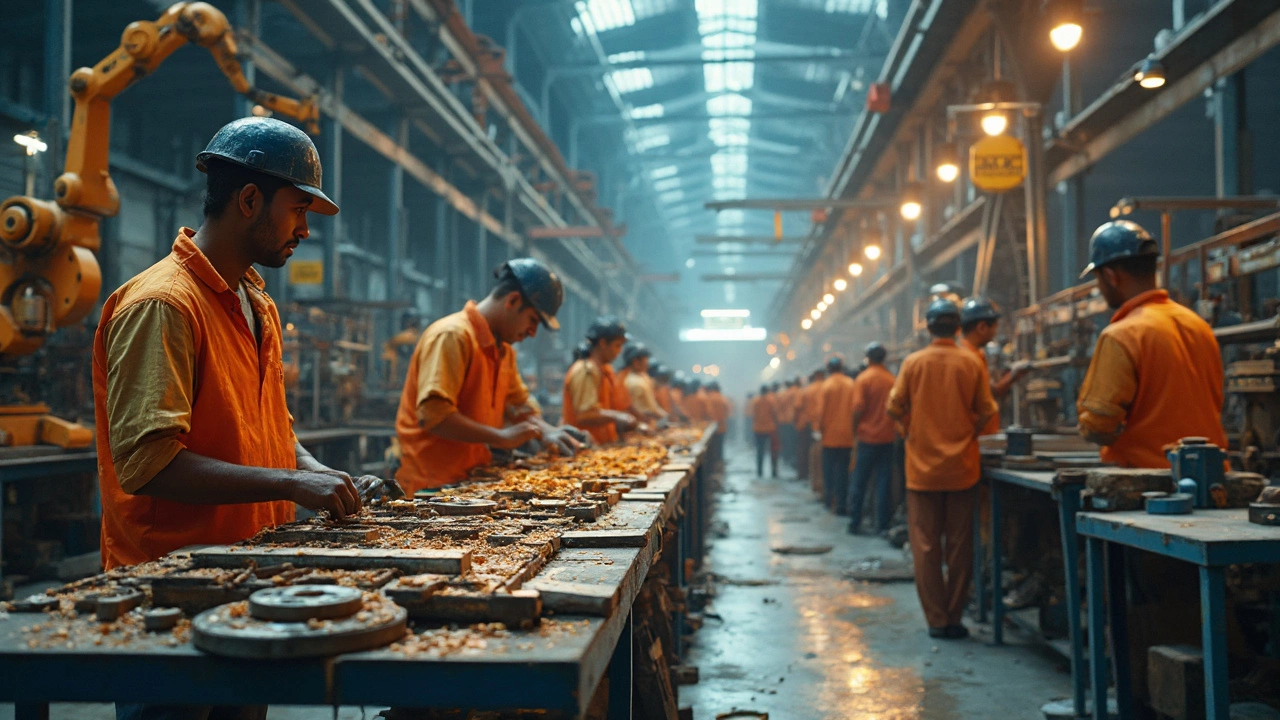6M in Manufacturing: The Backbone of Efficient Production

Factories turn chaos into order—not by magic, but by following a few tried-and-true rules. That's where the 6M framework steps in. If all you know about manufacturing is conveyor belts and machines, you're missing the big picture. The 6Ms cover Man, Machine, Material, Method, Measurement, and Mother Nature. Each one can make or break your production line.
People sometimes roll their eyes when they hear about frameworks, but here's the deal: some of the world's smoothest factories—from auto giants in India to electronics factories in South Korea—stick to the 6M checklist like it's gospel. Why? Because if something goes wrong on the floor, chances are it traces back to one of those six Ms. Think a batch of defective widgets or an unexpected delay. Knowing where to look saves time and money.
- What is 6M?
- How the 6Ms Work in Real Life
- Why Governments Back the 6M Approach
- Common Mistakes (and How to Dodge Them)
- Tips for Using 6M in Your Own Shop
What is 6M?
The term 6M in manufacturing stands for six major factors that impact the success of any production process. These aren’t just buzzwords; they’re building blocks for making products that meet standards without wasting time or money. Here’s what each “M” means:
- Man – This is about the people running the show. Their skills, training, and attitude can totally shift the quality or speed of the output.
- Machine – Equipment, tools, and technology all get roped in here. A minor machine glitch can slow down the line or pump out bad parts.
- Material – No one can make a good product out of junk. Incoming material quality, consistency, and handling are game-changers for cost and quality.
- Method – It’s about how work gets done. The procedures, processes, or instructions used can prevent mistakes or cause chaos.
- Measurement – You’ve got to track performance. If you’re not measuring things right—like size, temperature, weight—nothing stays under control.
- Mother Nature – Environmental factors sneak into production more than you’d guess. Things like temperature, humidity, or dust play a bigger role than most folks think.
Why is this list such a big deal? When a problem hits, experienced managers check each “M” rather than playing the blame game. According to a 2023 industry report, nearly 80% of production errors trace back to just one of these categories. That’s why quality control and process improvement meetings often revolve around the 6Ms.
If you want a side-by-side view, check this out:
| 6M Factor | What Can Go Wrong? |
|---|---|
| Man | Insufficient training, human error |
| Machine | Breakdowns, outdated tech |
| Material | Poor quality, inconsistent supply |
| Method | Bad procedures, missing steps |
| Measurement | Wrong tools, faulty readings |
| Mother Nature | Humidity, temperature swings |
Think of the 6M approach as a troubleshooting tool. If output drops or defects double, it’s a checklist for where to start looking. You don’t have to be a quality manager to use it—anyone on the factory floor can spot issues using these six tags.
How the 6Ms Work in Real Life
The 6Ms aren’t just for textbooks—they show up on every shop floor, every day. Let’s break down what each M looks like when you’re running a real factory or small business, not some simulation.
- Man: This one’s about your workers and their skills. If operators aren’t trained right, mistakes creep in. For example, Toyota’s factories invest in job-specific training. It’s one reason they have some of the lowest defect rates in the world.
- Machine: Downtime burns cash. A 2024 survey by IndustryWeek found unplanned equipment failures cost manufacturers up to $260,000 per hour. Regular maintenance and smart upgrades can slash those costs.
- Material: Ever seen a line stop because the wrong parts arrived? In the food industry, tainted ingredients have caused major recalls. Reliable suppliers and regular checks keep quality stable.
- Method: It matters how you do the work. Take semiconductors—if the cleaning process isn’t followed perfectly, you get a whole batch of useless chips. Standard work instructions (think: clear how-to guides) mean fewer "what the heck happened" moments.
- Measurement: If you don’t measure it, you can’t fix it. Indian pharma plants now use RFID systems to trace each pill, pouring data into dashboards so managers spot trends before problems grow.
- Mother Nature: Weather and environment can mess with production. Monsoon season in Bangladesh often leads to power outages in garment factories, so backup generators aren’t optional—they’re essential.
Here’s a quick look at how these factors actually hit the bottom line in different sectors:
| 6M Factor | Common Issue | Possible Fix |
|---|---|---|
| Man | Poor training leads to high rework rates | Hands-on workshops, certification |
| Machine | Frequent breakdowns | Preventive maintenance schedule |
| Material | Defective supplies halt production | Closer supplier audits |
| Method | Confusing instructions | Clear, step-by-step SOPs |
| Measurement | Missed quality targets | Real-time monitoring tools |
| Mother Nature | Production stops during storms | Invest in reliable backup power |
The 6M approach isn’t just about theory. Each piece has a real impact on quality and profits. Get one M wrong, and you’re likely dealing with missed orders and extra costs. Nail them all, and your operation runs smooth—even when things get bumpy.

Why Governments Back the 6M Approach
When you look at big manufacturing hubs—like Maharashtra in India or Guangdong in China—government agencies aren't just sitting on the sidelines. They actively push the 6M framework because it cuts waste, lowers error rates, and pumps out products that can compete everywhere from Tokyo to Berlin.
In 2022, India's Ministry of Micro, Small, and Medium Enterprises included 6M training in their LEAN Manufacturing Competitiveness Scheme. This wasn't just for big corporations. They targeted small shops too, showing them how 6M could help them land higher-value contracts and create more jobs.
Here's what makes governments so keen on the 6M approach:
- Boosts Quality Control: When factories follow the 6M, they catch problems early, like faulty parts or outdated machines, before an entire batch is wasted.
- Creates Jobs: More efficient factories need skilled workers to manage and improve each "M," which means more jobs and training opportunities.
- Makes Exports Strong: Consistent quality gives local businesses a better shot at selling their stuff abroad, which brings in more money and creates even more work.
- Lowers Waste: With tight checks on materials and methods, money isn’t literally being thrown away through defects or downtime.
You don't have to take my word for it. The International Organization for Standardization (ISO), which helps set global manufacturing standards, sums it up this way:
“A systematic approach such as 6M strengthens product quality and reduces variability, which is essential for businesses to thrive in global markets.” — ISO Annual Report, 2023
Check these stats from last year that drive the point home:
| Country | Makers Adopting 6M | Drop in Defects (%) | Increase in Productivity (%) |
|---|---|---|---|
| India | 34% | 14 | 11 |
| Japan | 87% | 9 | 8 |
| Brazil | 28% | 10 | 13 |
Bottom line? Governments care about 6M because it works, not just for gigantic factories but for the little guys getting their foot in the door too. They roll out grants, free training, and even certification programs to make sure everyone’s on board.
Common Mistakes (and How to Dodge Them)
Even experienced teams trip up on the 6M framework if they aren’t paying attention. It’s not rare to see a plant get stuck with the same issue for months, only to realize the cause was right under their nose. Here are some common mistakes people make with the 6Ms and some ways to sidestep them.
- Ignoring "Mother Nature": Lots of folks forget things like humidity, temperature, or dust. For example, a study of food factories showed up to 22% higher defect rates during peak summer because they overlooked heat’s effect on ingredients and machines. Always log and check environmental factors—they sneak up on you.
- Taking "Man" for Granted: It’s easy to blame machines, but sometimes the real issue is training gaps or fatigue. Changeovers after lunch or at the end of shifts are classic trouble spots. A regular skills workshop or quick safety drill keeps your crew sharp.
- Trusting "Measurement" Blindly: If your gauge or sensor is off, the data means nothing. According to a 2023 survey of Indian auto plants, 15% of quality claims came from unchecked measurement tools drifting out of calibration. Keep a maintenance schedule for every measuring device—don’t wait until it’s too late.
- Materials Mix-ups: Swapping suppliers or getting a "good deal" on materials sometimes backfires. The construction sector saw a 12% rise in rework in 2022 after switching to cheaper raw material grades. Always double-check specs and test small batches before changing up your supply chain.
- Overlooking "Machine" Maintenance: Lubricating, inspecting, and replacing parts on schedule seems boring—but skipping it means breakdowns just when you need to ship. Research shows that unplanned downtime costs manufacturers an average of $50K per hour. Regular checks are cheaper than emergency repairs.
Here’s a quick stats snapshot of where mistakes happen most, based on a 2024 survey of 120 manufacturing units:
| 6M Area | % of Issues Reported |
|---|---|
| Man | 19% |
| Machine | 23% |
| Material | 18% |
| Method | 15% |
| Measurement | 14% |
| Mother Nature | 11% |
If you want to stay ahead, make these checks routine. Addressing these small issues early will save you a lot of hassle—and cash—down the road.

Tips for Using 6M in Your Own Shop
Getting the 6M framework working for your shop isn’t about fancy theory—it’s about sticking to real habits that smart factories use every day. Start simple: print out the six Ms and stick them on your wall. Every time something gets messed up or is off schedule, ask your team, “Which M tripped us up?” That’s honestly half the battle.
- Man: Check in with your team regularly. Are skills up-to-date? The Toyota Production System found that better-trained workers cut errors by over 30% compared to less-trained teams. Invest in quick, focused training sessions every few months.
- Machine: Don’t wait for breakdowns. Follow a strict maintenance schedule. According to a 2023 government report, shops that keep monthly maintenance routines reduce downtimes by as much as 25% over those that fix things only when they break.
- Material: Inspect incoming materials as soon as they arrive, not after they’re in production. One small manufacturer in Chandigarh dropped defects in finished products by 18% just by adding a materials checklist at delivery.
- Method: Standardize your work instructions. Simple cheat sheets by machines boost consistency and help when you have new hires. A quick process audit twice a year pays off big.
- Measurement: Always measure before you assume. Attach simple measuring tools—like gauges or checklists—at key points. A 2022 study found that plants using regular measurement cut recall rates nearly in half.
- Mother Nature: Keep tabs on temperature, humidity, and dust, especially if you’re in food or electronics. Even small weather changes mess things up: humidity spikes slowed packaging lines by 12% in a Maharashtra plant last summer.
If you want to see where you stand, try a quick self-audit. Rate your attention to each M on a scale from 1 to 5. Here’s a simple table dozens of shop managers use to track progress every quarter:
| 6M Factor | Current Score (1–5) | Short Note |
|---|---|---|
| Man | 4 | Team regularly trained, need to refresh safety |
| Machine | 3 | Maintenance done, but tracking not documented |
| Material | 2 | Sometimes skip incoming checks under stress |
| Method | 4 | Standard work sheets mostly followed |
| Measurement | 5 | Regular checks and feedback cycles |
| Mother Nature | 3 | Only monitor in extreme weather |
Take ten minutes once every quarter with your team to fill this table. If any M scores below 3, make it your top fix for the next month. It’s a quick move, but it pays off in higher output and lower stress. That’s the whole point of using the 6M framework: less chaos, more control, and better results you can count on.